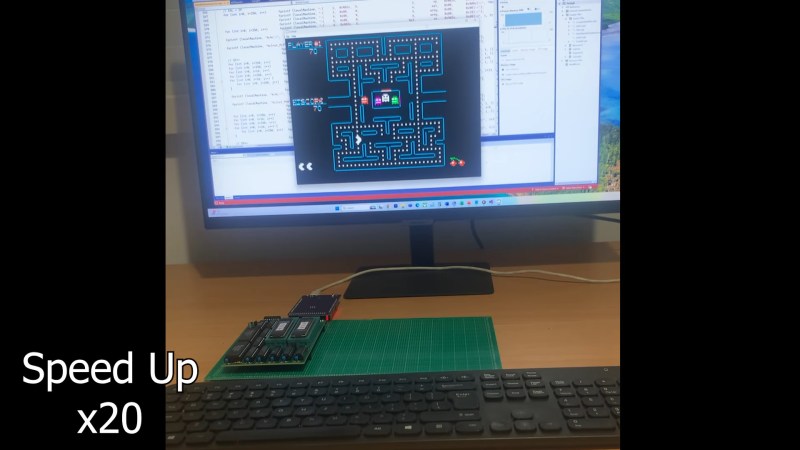Building a Commodore 64 is among the easier projects for retrocomputing fans to tackle. That’s because the C64’s core chipset does most of the heavy lifting; source those and you’re probably 80% of the way there. But what if you can’t find those chips, or if you want more of a challenge than plugging and chugging? Are you out of luck?
Hardly. The video below from [DrMattRegan] is the first in a series on his scratch-built C64 that doesn’t use the core chipset, and it looks pretty promising. This video concentrates on building a replacement for the 6502 microprocessor — actually the 6510, but close enough — using just a couple of EPROMs, some SRAM chips, and a few standard logic chips to glue everything together. He uses the EPROMs as a “rulebook” that contains the code to emulate the 6502 — derived from his earlier Turing 6502 project — and the SRAM chips as a “notebook” for scratch memory and registers to make a Turing-complete random access machine.
[DrMatt] has made good progress so far, with the core 6502 CPU built on a PCB and able to run the Apple II version of Pac-Man as a benchmark. We’re looking forward to the rest of this series, but in the meantime, a look back at his VIC-less VIC-20 project might be informative.
Thanks to [Clint] for the tip.
















Awesome project. Love seeing retro tech brought to life with pure creativity and modern components, excited for the next part in the series.
So it’s a microprogrammed machine. Well done. I talked with our new hires when I was working. The processors we designed in the 70s with pencil and paper, they now design with Verilog and VHDL and implement on FPGAs. How the world has changed…
I’ll take pencil, paper and karnaugh maps over VHDL.
I bought a dev board and tried to write a simple gameboy clone in VHDL. I failed completely and it felt like trying to wipe using glass wool.
You would need a few pencils to model a Gameboy with Karnaugh maps…
I prefer Verilog over VHDL, but both are very usable. For implementing an existing device, check how much of the logic you can find already done and debugged (CPU, display controller, etc). Then no the rest in the most common language.
…do the rest, not ‘no the rest’
If this is your first FPGA project, start with something simpler than a Gameboy. Try basic digital elements, such as counters or shift registers to get a grasp of definition language. Look at other peoples designs and try to understand how they work.
A simple digital clock is a good starting project.
no features?
no hdmi? no usb, no mobility (power), no yoistick? no faster memory?
Tell me you didn’t watch the video without telling me you didn’t watch the video
A rebuild of a SID, including both digital and analog parts would be very cool
That and the VICII will be really interesting to see.
Kawari is an excellent VIC replacement. PLA chip and SID chip have been replaced with modern equivalent with good result (except to the few with very sensitive ears)|
CIA has been replaced with J-CIA. I think every major part has modern day replacement and still be a full C64
In the past, the EPROM was also being used as a replacement for the C64 PLA.
https://www.geocities.ws/sieg.peter/pla/pla.html
Akin to the Novasaur,
https://hackaday.io/project/164212-novasaur-cpm-ttl-retrocomputer
Fantastic! What a project.
What else are you working in?
…and not one word about the unit using a 6502 clone in a machine design that REQUIRES the capabilities of the 6510 to actually create a C64 clone. The phrase “but close enough” indicates that the unit will never be able to do what the original could do.
and by “capabilities” you mean couple extra IO pins mapped to address 0, indeed space technology lost to sands of time, unreplicable forever!
The fact that this guy was able to build a fully functioning 6502 using 2 EEPROM chips, 2 SRAM chips and a handful of flip flops (plus a latch and some or gates) is amazing IMO.
8 MB of ROM (or maybe even 16mb?), considering there is only ~60 opcodes you could fit awful lot of straight up translations 1:1 with no computing in those two eproms alone.
I am confused…. I think there is a mix up.. “This video concentrates on building a replacement for the 6502 microprocessor — actually the 6510, but close enough”. The 6502 was the Original gen CPU while the 6510 is the enhanced version designed for the original C64. So i am not sure why it was mentioned that they sourced the 6510 as the “alternative” to the original in the C64